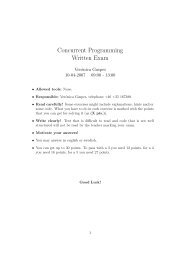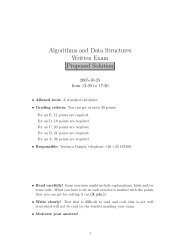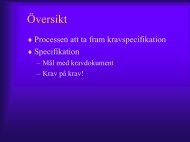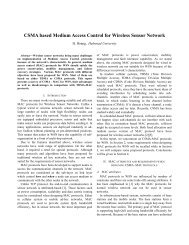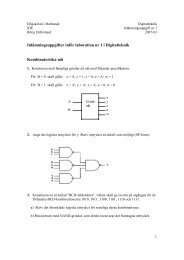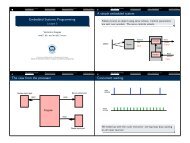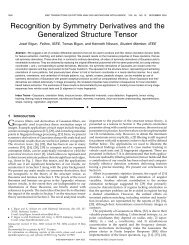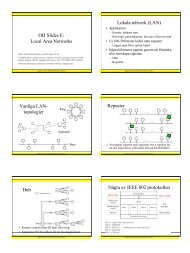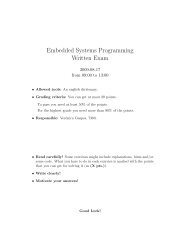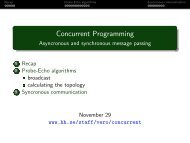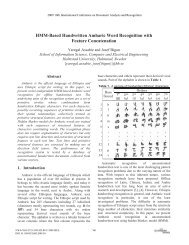Offline handwritten Amharic word recognition
Offline handwritten Amharic word recognition
Offline handwritten Amharic word recognition
You also want an ePaper? Increase the reach of your titles
YUMPU automatically turns print PDFs into web optimized ePapers that Google loves.
Pattern Recognition Letters 32 (2011) 1089–1099Contents lists available at ScienceDirectPattern Recognition Lettersjournal homepage: www.elsevier.com/locate/patrec<strong>Offline</strong> <strong>handwritten</strong> <strong>Amharic</strong> <strong>word</strong> <strong>recognition</strong>Yaregal Assabie a,⇑ , Josef Bigun ba Department of Computer Science, Addis Ababa University, Ethiopiab School of Information Science, Computer and Electrical Engineering, Halmstad University, SwedenarticleinfoabstractArticle history:Received 29 September 2009Available online 17 February 2011Key<strong>word</strong>s:<strong>Amharic</strong>Ethiopic scriptHandwriting <strong>recognition</strong>Word <strong>recognition</strong>OCRHMMThis paper describes two approaches for <strong>Amharic</strong> <strong>word</strong> <strong>recognition</strong> in unconstrained <strong>handwritten</strong> textusing HMMs. The first approach builds <strong>word</strong> models from concatenated features of constituent charactersand in the second method HMMs of constituent characters are concatenated to form <strong>word</strong> model. In bothcases, the features used for training and <strong>recognition</strong> are a set of primitive strokes and their spatial relationships.The <strong>recognition</strong> system does not require segmentation of characters but requires text linedetection and extraction of structural features, which is done by making use of direction field tensor.The performance of the <strong>recognition</strong> system is tested by a dataset of unconstrained <strong>handwritten</strong> documentscollected from various sources, and promising results are obtained.Ó 2011 Elsevier B.V. All rights reserved.1. Introduction<strong>Amharic</strong> is the official language of Ethiopia which has a populationof over 80 million at present. The language is believed to be derivedfrom Geez, the liturgical language of Ethiopia since the 4thcentury AD. <strong>Amharic</strong> belongs to Afro-Asiatic language family, and todayit has become the second most widely spoken Semitic languagein the world, next to Arabic (Gordon, 2005). Along with other Ethiopianlanguages, <strong>Amharic</strong> uses Ethiopic script for writing. Ethiopicscript has been in use since the 5th century BC (Gerard, 1981) andthe recently standardized alphabet has a total of 435 characters, withseveral languages having their own special sets of characters representingthe unique sounds of the respective languages. The Ethiopicscript used by <strong>Amharic</strong> has 265 characters including 27 labializedcharacters (which are mostly representing two sounds, e.g. for) and 34 base characters with six orders representing derived vocalsounds of the base character. The alphabet is written in a tabularformat having seven columns where the first column represents thebase characters and others represent their derived vocal sounds. Thevowels of the alphabet are not encoded explicitly but appear as modifiersof the base characters, a characteristics of Semitic writing. Partof a <strong>handwritten</strong> alphabet is shown in Table 1.There are dozens of languages across the world with their ownalphabets for writing. The advent of computing machines and theneed for processing large volumes of data motivated researchand development for automatic <strong>recognition</strong> of texts. Scripts withindustrial and commercial importance received the earliest⇑ Corresponding author.E-mail addresses: yaregal@cs.aau.edu.et (Y. Assabie), josef.bigun@hh.se (J.Bigun).attention from researchers and developers of handwriting <strong>recognition</strong>.For example, offline <strong>recognition</strong> of Latin, Chinese, Japanese,Indian, and Arabic <strong>handwritten</strong> text has long been an area of activeresearch and development (Arica and Yarman-Vural, 2001; Bunke,2003; Lorigo and Govindaraju, 2006; Suen et al., 2003). However,Ethiopic handwriting <strong>recognition</strong> in general, and <strong>Amharic</strong> <strong>word</strong><strong>recognition</strong> in particular, is one of the least investigated problems.The purpose of automatic <strong>recognition</strong> of texts is to convert textsstored in a paper or other media to a standard encoding schemerepresenting the texts, e.g. ASCII or Unicode to the effect that efficientautomatic services can be provided, e.g. searching in a text,postal distribution of letters, payment of checks, form extraction,etc. The conversion can be made online (at the time of writing)or offline (after writing is completed). Online <strong>recognition</strong> benefitsfrom the temporal information captured when the text is writtenand better results are usually obtained as compared to its equivalentoffline <strong>recognition</strong>. <strong>Offline</strong> text can be machine-printed or<strong>handwritten</strong>. Recognition of machine-printed text is consideredto be a manageable problem. Several techniques applied on suchdocuments are proved to be working in a wide range of real lifeapplications for non-Ethiopic scripts (Mori et al., 1992; Srihari,1992; Srihari et al., 1997) as well as Ethiopic script (Mesheshaand Jawahar, 2005; Assabie and Bigun, 2007). However, offline <strong>recognition</strong>of unconstrained <strong>handwritten</strong> text is still one of the mostchallenging pattern <strong>recognition</strong> problems regardless of the writingsystem. The challenge mainly comes from cursiveness of handwriting,difficulty of detecting text lines, non-uniformity of spacesbetween characters and <strong>word</strong>s, inconsistency of a writer, and variabilityin writing styles of different writers. In addition to the commonproblems pertinent to most scripts, the difficulty in<strong>recognition</strong> of Ethiopic handwriting also arises from the relatively0167-8655/$ - see front matter Ó 2011 Elsevier B.V. All rights reserved.doi:10.1016/j.patrec.2011.02.007
1090 Y. Assabie, J. Bigun / Pattern Recognition Letters 32 (2011) 1089–1099Table 1A sample of <strong>handwritten</strong> Ethiopic characters.the remaining sections of this paper is as follows. The basic theoreticalbackgrounds of HMMs and a review of their application to handwriting<strong>recognition</strong> is presented in Section 2. In Section 3, theproposed <strong>recognition</strong> approaches along with feature selection strategiesare treated. Section 4 describes image processing, segmentation,and feature extraction techniques. Experimental results arereported in Section 5. We discuss about the overall <strong>recognition</strong> systemand conclude in Section 6.2. Hidden Markov Models (HMMs)Originally applied to the domain of speech <strong>recognition</strong>, HMMshave emerged as a powerful paradigm for modeling pattern sequencesin different areas such as bio-informatics, gesture <strong>recognition</strong>,online handwriting <strong>recognition</strong> and online signatureverification. Inspired by the success in such fields, they have alsoattracted a growing interest more recently in various computer visionapplications including offline handwriting <strong>recognition</strong>(Plamondon and Srihari, 2000; Rabiner, 1989).large number of characters, their interclass similarity and structuralcomplexity.There are two paradigms in handwriting <strong>recognition</strong>: segmentation-basedand holistic (Liu et al., 2003). Segmentation-based approachsegments <strong>word</strong> images into constituent characterswhereas holistic approach tries to recognize the whole <strong>word</strong> byignoring character segmentation. Holistic approach also extractsrepresentative features for the whole <strong>word</strong>, and it is more pragmaticin the case of cursive handwriting where characters are physicallyconnected with each other and segmentation turns out to beimpractical (Madhvanath and Govindaraju, 2001; Ruiz-Pinaleset al., 2007). In both cases, <strong>recognition</strong> of unconstrained <strong>handwritten</strong>text remains a challenging task with the current technology.Consequently, several handwriting <strong>recognition</strong> techniques havebeen proposed over the years, with none of them providing highaccuracy in unconstrained texts. Among the most commonly usedmethods are statistical approaches which include hidden Markovmodels (HMMs), Bayesian classifiers, support vector machines, fuzzyset reasoning, polynomial discriminate classifier, etc. (Arica andYarman-Vural, 2001; El-Yacoubi et al., 1999; Jain et al., 2000; Liuand Fujisawa, 2008). For noisy data, neural networks showed goodperformances, and promising results have been reported for <strong>handwritten</strong>digit <strong>recognition</strong> (Cheriet et al., 2007; Marinai et al., 2005).Handwriting <strong>recognition</strong> is also achieved by using elastic matchingwhich tolerates a certain range of geometric deformations of <strong>handwritten</strong>characters (Uchida and Sakoe, 2003). A structural approachis often applied for <strong>recognition</strong> by representing more complexstructures using simpler graphical units and their relationships(Shi et al., 2003). Moreover, it has been shown that the use of multipleclassifiers has a potential to improve <strong>recognition</strong> accuracy (Cherietet al., 2007; Koerich et al., 2002). Recognition results can befurther improved by the use of contextual information based on linguistictools, e.g. analyzing at <strong>word</strong> level using spell checking techniquesbased on lexicon. Part of speech (POS) tagger also improvesthe <strong>recognition</strong> results by syntactically analyzing at sentence level(Fujisawa, 2008; Suen et al., 2003; Vinciarelli et al., 2004).In this paper, we present <strong>Amharic</strong> <strong>word</strong> <strong>recognition</strong> in unconstrained<strong>handwritten</strong> text using HMMs. To the best of our knowledge,offline <strong>handwritten</strong> <strong>Amharic</strong> text has not been studiedbefore. We also present a dataset of unconstrained <strong>handwritten</strong><strong>Amharic</strong> text collected from various sources. 1 Currently, there areno publicly available datasets for such studies. The organization of1 The dataset is made available to the public and can be accessed by contactingauthors.2.1. Problem statementHMMs are doubly stochastic processes which model time varyingdynamic patterns. The system being modeled is assumed to be aMarkov process that is hidden (not observable), but can be observedthrough another stochastic process that produces the sequence ofobservations (Rabiner and Juang, 1986). The hidden process consistsof a set of states connected to each other by transitions with probabilities,while the observed process consists of a set of outputs orobservations, each of which may be emitted by states according tosome output probability density function. Depending on the probabilitydensity functions, HMMs can be discrete or continuous.HMMsare characterized by the following parameters (Rabiner, 1989): N, the number of states in the model. Individual states aredenoted as S ={S 1 ,S 2 ,...,S N }, where the state at time t is denotedby the variable q t and it takes one of the states in the set S asvalue. M, the number of distinct observation symbols per state,denoted as V ={v 1 ,v 2 ,...,v M }. A ={a ij }, the state transition probability distribution wherea ij = P(q t+1 = S j jq t = S i ), 1 < i, j 6 N. B ={b j (k)}, the observation symbol probability distribution instate j, where b j (k)=P(v k at tjq t = S j ), 1 6 j 6 N, 16 k 6 M. p ={p i }, the initial state distribution, where p i = P(q 1 = S i ),1 6 i 6 N.The above HMM is represented by a compact notation:k ¼fA; B; pgFor the HMM model with the compact notation, there are three basicproblems that must be solved: evaluation, decoding, and trainingproblems. Fortunately, the theories behind HMMs are based onstrong statistical and mathematical foundations which solve thestated problems. The evaluation problem is solved by forward–backwardprocedure; the decoding problem can be solved by using theViterbi algorithm; and the training problem is solved by Baum-Welchalgorithm. Further details are presented in (El-Yacoubi et al., 1999;Rabiner, 1989; Young et al., 2006).2.2. Application to handwriting <strong>recognition</strong>There is a growing number of researches investigating theapplication of HMMs for handwriting <strong>recognition</strong>. The rewardcomes from the fact that HMMs have strong theoretical and statis-ð1Þ
Y. Assabie, J. Bigun / Pattern Recognition Letters 32 (2011) 1089–1099 1091tical foundation to cope with noise and variability of data, of which<strong>handwritten</strong> text is a typical example. Recognition of isolated<strong>handwritten</strong> characters can be done using HMMs by building amodel for each character. Since the number of characters in a scriptis not very large, it is possible to collect sufficient training data foreach class. The same is true for a small set of <strong>word</strong>s in a specificapplication such as <strong>recognition</strong> of city names and bank checks,where sufficient training data can be made available and a modelcan be built for each <strong>word</strong>. In the case of general purpose <strong>handwritten</strong>text <strong>recognition</strong>, the number of <strong>word</strong>s becomes hugeresulting in a problem to collect sufficient training data and buildHMM for each <strong>word</strong>. Thus, the traditional way of using HMMsfor <strong>handwritten</strong> <strong>word</strong> <strong>recognition</strong> is by concatenation of HMMsof characters constituting the <strong>word</strong> (El-Yacoubi et al., 1999; Koerichet al., 2003). Like other <strong>recognition</strong> methods, HMM-based <strong>recognition</strong>systems usually require preprocessing procedures such asslant correction and size normalization. After normalization, inputfeatures are usually extracted by moving a sliding window in theimage from left to right to produce a sequence of observations.The features are extracted in each window frame using imagetransformations, such as cosine transform, Fourier transform, andKarhunen–Loève transform.3. The proposed <strong>recognition</strong> systemIn our method, we use structural features of characters as thebuilding blocks of the <strong>recognition</strong> system. We propose two methodsof <strong>recognition</strong> strategies both of which are using these structuralfeatures. In both cases, <strong>recognition</strong> of a <strong>word</strong> image is madeby decoding the hidden states for the observed sequences of<strong>word</strong>-level structural features. The components of the <strong>recognition</strong>system are discussed below in detail.3.1. Feature designThe design of suitable features is one of the most important factorsin achieving good <strong>recognition</strong> results. It should be made insuch a way that features represent the most relevant informationfor the classification purpose at hand. Here is it determined byminimizing the intra-class pattern variability while enhancingthe inter-class pattern variability. In this work, feature vectorsare computed from the structural features, i.e. primitive strokesand their spatial relationships, which are extracted in sequentialorder based on their spatial arrangements. Primitive strokes areformed from vertical and diagonal lines and end points of horizontallines, whereas connectors are defined as horizontal lines betweentwo primitives. Primitive strokes for <strong>handwritten</strong>characters are hierarchically classified based on their orientation/structure type, relative length within the character, and relativespatial position. A description of similar features is exposed in(Assabie and Bigun, 2007) where they were first used for multifontand size-resilient <strong>recognition</strong> of machine-printed Ethiopic characters.For the purpose of computation, each classification level is assignednumbers as labels ranging from 6 to 9. The hierarchy ofclassification is given as follows.i. Orientation/structure type: There are three groups of orientationsfor primitive strokes namely, forward slash (label 2 9),vertical (8), and backslash (7). Appendages (6) do not fit to aspecific orientation. Rather, they are recognized by their structuretype in the case of machine printed text, e.g. in wherethere are three appendages placed at the end of horizontal2 For convenience we drop the <strong>word</strong> label in the sequel when it is clear from thecontext.lines. However, in <strong>handwritten</strong> text, appendages are usuallynot marked well and we de ne them as the end points of horizontallines as in .ii. Relative length: The orientation of primitives is further classifiedbased on their relative length as long (9), medium (8), andshort (7). Long is defined as a primitive that runs from the topto the bottom of the character, where as short is a primitivethat touches neither the top nor the bottom of the character.Medium refers to a primitive that touches either the top orthe bottom (but not both) of the character. Due to their smallsize, appendages are always considered as short.iii. Relative spatial position: At this level of classification hierarchy,primitives are further classified according to their spatialposition with in the character as top (9), top-to-bottom (8),bottom (7), and middle (6). Short primitives can only have arelative spatial position of middle. Top-to-bottom positionapplies to long primitives which run from the top to the bottomof the character. Primitives with medium relative sizecan have either top or bottom spatial position. Appendagesmay appear at the top, middle, or bottom of the character.The above classification scheme results in 15 types of primitivestrokes, which are used to represent all the 435 Ethiopic characters.Table 2 summarizes lists of these primitive strokes and theirnumerical codes. The example characters in the table contain severalprimitive strokes, but only one of them pointed by arrowsillustrates the respective entry. The example primitive strokes foreach entry are further indicated in the last column where theyare extracted from the respective example characters. Note thathorizontal lines are classified as connectors between two primitivestrokes, and only their endpoints are classified as appendageswhich are shown as dots in the primitive strokes column.As aforementioned, there exist horizontal strokes but these areevidences of connections between two primitives. The way twoprimitives are connected to each other with horizontal lines is referredto as spatial relationship. A primitive can be connected to anotherat one or more of the following regions: top (1), middle (2),and bottom (3). A connection between two primitives is representedby xy where x and y are numbers representing connectionregions for the left and right primitives, respectively. Betweentwo primitives, there can also be two or three connections, and atotal of 18 spatial relationships are identified as shown in Table3. The first connection found as one goes from top to bottom ofconnected primitives is defined as principal connection. There area total of nine principal connections where only three of them(11, 12 and 21) allow additional connections which are termedas supplementary connections.A spatial relationship between two primitives is defined to havesix feature values where a value of zero is padded at the beginningfor those whose number of connections are two or less. For example,the feature value of a spatial relationship of the type 13 ( ) willbe {0,0,0,0,1,3}. The sequential order of primitive strokes A and Bis represented as AB if A is spatially located at the left or top of B.Each primitive is connected to another one to the left except thefirst primitive in each character, in which case it does not haveany one to be connected to the left. In such cases, all the six featurevalues for such spatial relationship will be all zeros.3.2. The character feature listThe character feature list stores possibly occurring sequences ofprimitive strokes and their spatial relationships for each characterin the alphabet. Each primitive stroke appearing in a character isrepresented by a feature vector of nine digits of which the firstsix are for the spatial relationships and the last three are for theprimitive strokes. Thus, a single sample of a character is repre-
1092 Y. Assabie, J. Bigun / Pattern Recognition Letters 32 (2011) 1089–1099Table 2Classification of primitive strokes.Table 3Connection types between primitives.phase decodes the input data based on the observation sequence.Below we discuss the two proposed methods: feature-level andHMM-level concatenation. In both cases, Baum–Welch algorithmis used for training and Viterbi algorithm is used for <strong>recognition</strong>.3.3.1. Feature-level concatenation methodIn this method, training samples for a given <strong>word</strong> are generatedfrom a character feature list which stores possibly occurring samplefeatures for each character. Suppose that the input <strong>word</strong> W hassequences of characters C 1 , C 2 , C 3 , ..., C m , where m is the total numberof characters making up the <strong>word</strong>. Then, sample features of the<strong>word</strong> are generated as all combinations of sample features of eachcharacter, yielding w sample features of the <strong>word</strong> computed as:w ¼ YmnðC i Þi¼1ð2Þsented by sequences of feature vectors where each vector has ninedigitvalues. The character feature list is a collection of such sequencesof feature vectors generated by various sample characters.A character can have many sample features stored in the characterfeature list reflecting variations of writing styles and slants. Thishelps to train the system with slanted characters as well, and asa result it does not require slant correction later in the image preprocessingstage. Fig. 1 illustrates different <strong>handwritten</strong> symbolsfor the character.3.3. Training and <strong>recognition</strong>The goal of the training phase is to estimate the parameter valuesof models from a set of training samples, and the <strong>recognition</strong>where n(C i ) is the total number of samples for character C i . Fig. 2shows a sample feature for the <strong>word</strong> generated from the characterfeature list. Each group in the rectangular box beneath charactersrepresents sample features for the corresponding character,whereas each line represents a feature vector of primitives and theirassociated spatial relationships.After generating sample features for the input <strong>word</strong>, the nextprocedure is HMM initialization which sets a prototype for HMMof the <strong>word</strong> to be trained including its model topology, transitionand output distribution parameters. A simplified flowchart oftraining and <strong>recognition</strong> procedures is shown in Fig. 3. The dotted-linebox in the flowchart shows repetitive tasks for each <strong>word</strong>.Gaussian probability function that consists of means and variancesis used to define the model parameters. The number of statesof a <strong>word</strong> corresponds to the total number of primitive strokes inthe <strong>word</strong>. The HMM topology of which has eight primitivestrokes is shown in Fig. 4. Once the HMM is trained with samplefeatures of the <strong>word</strong>, the model is stored into a master model filewhich will be used later during the <strong>recognition</strong> phase.In the <strong>recognition</strong> phase, <strong>handwritten</strong> text image is processed todetect lines and segment <strong>word</strong>s. For each <strong>word</strong> in the text image, asequence of primitive strokes and their spatial relationship is extracted.Fig. 5 shows primitive strokes and spatial relationshipsidentified for the <strong>handwritten</strong> <strong>word</strong> Then, the sequence is generatedas: {{aA,bB,cC}, {dD, E}, {fZ,gH,lM}}, where the Greekcapital letters represent primitive strokes and smaller letters rep-
Y. Assabie, J. Bigun / Pattern Recognition Letters 32 (2011) 1089–1099 1093Fig. 1. Various <strong>handwritten</strong> symbols for the character .Fig. 4. HMM topology for the <strong>word</strong>in feature-level concatenation.Fig. 2. Generation of sample feature for the <strong>word</strong> .Fig. 5. Structural features for the <strong>handwritten</strong> <strong>word</strong> .Fig. 3. Training and <strong>recognition</strong> flowchart in feature-level concatenation method.resent associated spatial relationships. Note that a, d, and f are notshown in the figure since they correspond to a spatial relationshipof the first primitive stroke in each character, in which they do nothave primitive to the left to be connected with. Once structural featuresare identified and classified, they are assigned with featuresvalues as discussed in Section 3.1. Then, the extracted feature sequencesare considered as observations which are used by the decoderfor <strong>recognition</strong>. For the most part of <strong>Amharic</strong> <strong>word</strong>s, a singlemodel is built for each of them. However, comparatively few <strong>word</strong>scan also have more than one models for two reasons. The first isbecause of characters (along with their derivatives) which representthe same sound but different shapes. Groups of base charactersrepresenting the same sound are: , , and. A <strong>word</strong> containing the sounds of such characters and/ortheir derivatives can be written in several ways. For example,one can write the <strong>word</strong> also in various ways as: ,, , , , , , , , etc.While some of them may look awkward to native users, they arenot considered as wrong, and readers can still get the same meaning.However, as far as the <strong>recognition</strong> system is concerned, theyhave different features and consequently they are treated as different<strong>word</strong>s. Therefore, despite the same sound and meaning, differentmodels are built for each of them. The second reason is thatthere are some variations in writing styles of a character resultingin different number of primitives to be extracted for the same character.For example, <strong>handwritten</strong> symbols , , and representthe same character yielding 2, 4, and 5 primitive strokes,respectively. Accordingly, the number of states of HMMs for <strong>word</strong>scontaining this character will change. Thus, for such cases where asingle <strong>word</strong> with the same set of characters results in two or moremodels, the <strong>word</strong> is temporarily given different <strong>word</strong> codes with
1094 Y. Assabie, J. Bigun / Pattern Recognition Letters 32 (2011) 1089–1099Fig. 6. HMM topology ofrespect the models. They are treated as different <strong>word</strong>s in thetraining and decoding phases, but will be given the same label inthe output. Apart from building multiple models, such <strong>word</strong>s donot incur extra complexities on training and <strong>recognition</strong>.3.3.2. HMM-level concatenation methodWhile the training and <strong>recognition</strong> procedures remain similar tothat of feature-level concatenation method, the basic idea in HMMlevelconcatenation method is that HMMs are built for each characterfrom the stored sample features of characters, and the <strong>word</strong>model is made up of the concatenation of the constituent characterHMMs. Given a sequence of characters for a <strong>word</strong>, the final state ofa character HMM is connected to the initial state of the next character.The number of primitives in a character corresponds to thestates of its HMM. Two or more models could be built for a singlecharacter based on the number of primitives that character isformed from. Taking the above examples , , and which representthe same character , the character has three HMMs having3, 4, and 5 states with respect to the <strong>handwritten</strong> symbol types.Fig. 6 shows the HMM topology for the <strong>word</strong> formed by concatenationof the HMMs of constituent characters.3.4. Adaptabilityusing HMMs of constituent characters.gðx; yÞ ¼ 1 2pr exp x 2 þ y 22 2r 2where r is the standard deviation. With its separability property,the 2D Gaussian is more efficiently computed as convolution oftwo 1D Gaussians, g(x) and g(y), which are defined as follows 1gðxÞ ¼pffiffiffiffiffiffi2p r exp x 2ð4Þ2 2r 2 1gðyÞ ¼pffiffiffiffiffiffir exp y 2ð5Þ22p2r 2with the abuse of notation that g is used to mean both a 2D functiong(x,y) when it has two arguments, and a 1D function g(s),when it has one argument. In this work, we use gradient anddirection fields as tools for separating texts from background,detecting text lines and extracting features. We use Gaussiansand derivatives of Gaussians as filtering tools in the image processingphase. Below, we give a brief summary of both the gradientfield and the direction field tensor. The later is introduced byBigun and Granlund (1987) and exposed in further detail in (Bigun,2006).4.1. Gradient fieldGradient field has been used as a traditional tool over manyyears for feature extraction in image analysis problems (Kimet al., 1998; Tan et al., 1996). Gradient is a vector representingthe change in gray level in two orthogonal directions. This can becalculated by taking the difference in value of neighboring pixelsin a given pair of orthogonal directions, producing a vector for eachpixel. The magnitude of the vector at each pixel measures theamount of change in intensity, and the angle of the vector showsthe direction of maximal intensity changes and can be expressedin the range of [0...360) degrees. For a local neighborhood f(x,y)of an image f, the gradient field rf is computed by using Gaussianderivative operators D x and D yð3ÞThe proposed <strong>recognition</strong> system can be extended to accommodatenew <strong>word</strong>s. Since <strong>word</strong> features are generated from the featurelists of constituent characters, the system does not requireactual examples of <strong>handwritten</strong> <strong>word</strong>s. For any given <strong>word</strong>, the initialparameters are automatically set by the system and does notrequire manual intervention, e.g. the number of states are computedfrom the total number of primitives the <strong>word</strong> comprises.Therefore, it is possible to train <strong>word</strong>s easily for a specific set ofnew applications like postal address <strong>recognition</strong> and bank checkprocessing. Similarly, the same procedure can be taken to use thesystem for other Ethiopian languages. The requirement here is tomake sure that structural features for special character sets correspondingto the respective languages are added in the characterfeature list.4. Image processing and feature extractionFeature extraction is an essential part of pattern <strong>recognition</strong>systems with a direct effect on the result. In offline handwriting<strong>recognition</strong>, feature extraction involves image analysis and processing.One of the most commonly used filters for image processingare Gaussian filters and derivatives of Gaussians. Gaussian filteris frequently used as a low-pass filter for noise suppression andGaussian derivatives are used to detect and localize edges alongwith determining their orientation (Basu, 1994). The use of Gaussiankernels for image processing has become popular, among others,due to (i) their separability in the x and y directions, and (ii)directional isotropy, i.e. circular symmetry (Bigun et al., 2004).Mathematically, a 2D Gaussian kernel is defined as:rf ðx; yÞ ¼ðD x þ iD y Þf ðx; yÞ ¼ X jf j ðD x þ iD y Þgðx x j ; y y j Þ ð6Þand sampling the image at (x j ,y j ). It amounts to a convolution with aderivative of Gaussians. The complex partial derivative operatorD x + iD y is defined as:D x þ iD y ¼ @ @x þ i @ @yand used instead of the vector representation, as it has some notationaladvantages that will explained further below.4.2. Direction fieldsA local neighborhood with ideal local direction is characterizedby the fact that the gray value remains constant in one direction(along the direction of lines), and only changes in the orthogonaldirection. Since the directional features are observed along lines,the local direction is also called Linear Symmetry (LS). The LS propertyof an image can be estimated by analyzing the direction fieldtensor (Bigun, 2006; Bigun et al., 2004). The direction tensor, alsocalled the structure tensor, is a real valued triplet, which is a tensorrepresenting the local directions of pixels. For a local neighborhoodof an image f(x,y), the direction tensor, also called the structuretensor S, is computed as a 2 2 symmetric matrix using Gaussianderivative operators D x and D y .S ¼RRðDx f Þ 2 dxdyRRðDx f ÞðD y f ÞdxdyRR !ðDx f ÞðD y f ÞdxdyRRðDx f Þ 2 dxdyð7Þð8Þ
Y. Assabie, J. Bigun / Pattern Recognition Letters 32 (2011) 1089–1099 1095Fig. 7. (a) Handwritten <strong>Amharic</strong> text, (b) rf, (c) I 11 , and (d) I 20 of a.Linear symmetry exists among others at edges where there are graylevel changes and an evidence for its existence can be estimated byeigenvalue analysis of the direction tensor or equivalently by usingcomplex moments of order two which are defined as follows:Z ZI mn ¼ ððD x þ iD y Þf Þ m ððD x iD y Þf Þ n dxdy ð9Þwhere m and n are non-negative integers. Among other orders, ofinterest to us are I 11 , and I 20 derived as:Z ZI 11 ¼ jðD x þ iD y Þf j 2 dxdyð10ÞZ ZI 20 ¼ ððD x þ iD y Þf Þ 2 dxdyð11ÞI 11 is a scalar value that measures the amount of gray value changesin a local neighborhood of pixels and equals to the sum of eigenvaluesof S. The value of I 20 is a complex number where the argumentis the local direction of pixels in double anglerepresentation (the direction of major eigenvector S) and the magnitudeis a measure of the local LS strength (the difference of eigenvaluesof S). As illustrated in Fig. 7b and d, gradient and directionfield images can be displayed in color where the hue representsdirection of pixels (in double angle representation in the case ofdirection field tensor image) with the red 3 color corresponding tothe direction of zero degree. In Fig. 7d, the region with black colorrepresents pixels with low magnitudes and thus they are said tobe lacking LS properties. Whether a given pixel lacks LS propertyis determined by a threshold value. The scalar value I 11 can alsobe displayed as gray scale image as shown in Fig. 7c.In this work, we use rf and I 20 for image processing and analysis.The motivation of using both directional information comesfrom the respective reward they provide. The advantage of rf overI 20 is that its argument is computed with directions of pixels expressedwith [0...360) degrees, representing the left and rightedges (black-white, white-black transitions) differently. In the caseof I 20 , the resultant argument corresponds to the range of [0...180)degrees, with opposite edges mentioned not being discerned.While the direction information of I 20 is ‘‘phase-free’’, smoothing3 For interpretation of color in Fig. 7, the reader is referred to the web version ofthis article.of it in a window does not lead to cancelation effects from whichrf suffers. Another advantage of I 20 is that it automatically encodesthe optimal direction in the total least square error sense as thisoptional fitting is implicitly carried out by (tensor) averaging.The averaging process amplifies linear structures and suppressesnon-linear structures automatically. The gradient field, i.e. rf simplycomputes the differences in the intensity of pixels, withoutattempting to fit an optimal direction in the total least square errorsense. Their difference is clearly visible when using them in noisyimages. We use the synergy of both rf and I 20 for the following imageprocessing procedures.4.3. Text line detection and <strong>word</strong> segmentationText line detection and <strong>word</strong> segmentation are among the mostcritical sub-processes in character <strong>recognition</strong>. In the case of <strong>handwritten</strong>documents, there is no uniformity: text lines may not bestraight, the gap between <strong>word</strong>s may vary greatly, and charactersmay be physically connected. Because of these problems, automaticsegmentation poses a challenge for researchers in handwriting<strong>recognition</strong>. Thus, studies are still being carried out to detecttext lines (Li et al., 2006), and segment <strong>word</strong>s (Huang and Srihari,2008) and characters (Selvi and Indira, 2005) in <strong>handwritten</strong> documents.Although there are also other state of the art researchworks on text line detection and <strong>word</strong> segmentation (Bar-Yosefet al., 2009; Louloudis et al., 2009), we propose a new text linedetection and <strong>word</strong> segmentation technique that uses the directionfield image. The advantage here is that we continue to be workingon the resultant image that is computed to be used for featureextraction as well. Although, our proposed <strong>recognition</strong> system doesnot require the segmentation of characters, it is generated as abyproduct in the process of text line extraction and <strong>word</strong> segmentation.In the process, physically connected characters are emergingas a single character, whereas parts of a character which arenot connected with each other are over-segmented as severalparts. In either of the cases, a single segmented unit is termed aspseudo-character, but hereafter we simply refer to them as characters.The final result of this process is that the background is separatedfrom the foreground (text). The proposed algorithm whichextracts text lines and segment <strong>word</strong>s from the direction field
1096 Y. Assabie, J. Bigun / Pattern Recognition Letters 32 (2011) 1089–1099Fig. 8. (a) Character regions separated from the background, (b) character segmentation mapped onto the original text.(I 20 ) image passes through two phases. In the first pass, the imageis traversed from top to down and pixels are grouped into two asblocked and open regions. In the process, a pixel is sequentiallyclassified as open if it: is in the first row of the direction field image, lacks LS property and its immediate top pixel is open, lacks LS property and one of its sideways neighborhood is open.The remaining are grouped as blocked pixels. As the scanningprogresses each group of interconnected blocked pixels are designatedas character regions, and open pixels form the background.Fig. 8a shows blocked and open pixels for the <strong>Amharic</strong> <strong>handwritten</strong>text of Fig. 7a, with the black color representing blocked pixels andwhite representing open pixels. As a result of such pixel classification,ultimately we get foreground (character regions) separatedfrom the background. The boundaries of blocked pixels form bordersof segmented characters. Fig. 8b shows such character segmentationresults for the text shown in Fig. 7a.In the second pass, the resultant image (with the character regionseparated from the background) is traversed from left to rightgrouping each segmented character into appropriate text lines. Asthe traversal proceeds, the global and local directions of each textline are computed. The global direction is the average direction ofthe line passing through all member characters, and the local directionis computed from few characters at the head of text lines. Theglobal and local directions help predict the direction in which thenext member character is found. This is essential especially inskewed documents. During traversal, when a segmented characteris found, existing text lines compete for the character, and a textline is selected based on its proximity and legibility to the character.If the character is not within the local and global directions ofthe candidate text line, then the character forms a new line. Thistext line detection technique tolerates skewed documents becausewe follow the directions of text lines. Fig. 9 shows an automaticline detection in a skewed <strong>handwritten</strong> document. Words are thensegmented based on the relative gap R between characters withintext lines, defined as:R i ¼ G i G i 1 ð12Þwhere G i is the horizontal gap between the ith character and its predecessor.Although the horizontal gap between consecutive charactersvaries greatly, the relative gap suppresses those variations anda fixed threshold fairly segments <strong>word</strong>s. It should also be notedthat, as this procedure does not use contextual information, <strong>word</strong>segmentation will fail if gaps between characters in a <strong>word</strong> arenot slightly greater than gaps between <strong>word</strong>s.4.4. Feature extractionFeatures of segmented <strong>word</strong>s are extracted based on the optimaldirection of pixels. Once character regions are separated fromthe background, as discussed in the previous section, the boundariesof characters also form the boundaries of their primitivestrokes and connectors except in the case of holes. Holes areformed as a result of two or more connections between primitivestrokes in a character. As shown in Fig. 10b, which is a result ofthe character segmentation process applied on Fig. 10a, there arefour holes which are not yet identified as primitive strokes. Furtherprocesses to identify constituent primitive strokes forming holesare done using the combination of rf and I 20 images. The magnitudeof the I 20 and the angle of rf are combined resulting in optimizedlinear structures expressed with the range of [0...360)degrees. Noting that strokes in characters produce two edges (leftand right edges for vertical strokes, and top and bottom edges forhorizontal strokes), the angle of rf discriminates the two edgetypes. The magnitude of I 20 is used to classify whether a localneighborhood forms a linear structure or not. By mapping the characterboundaries on the combined directional image, as shown inFig. 10c, strokes are identified for each character of a given <strong>word</strong>image. Fig. 10d illustrates extracted strokes from a <strong>word</strong>. Strokesare further classified as primitive strokes and connectors basedon the direction information of their pixels. In the rf angle, strokepixels with directions (60...120) or (240...300) degrees are set asparts of connectors and the rest are considered as parts of primitivestrokes. Primitives are then further classified and assigned withfeature values using their direction, relative length, and spatialFig. 9. Text line detection.
Y. Assabie, J. Bigun / Pattern Recognition Letters 32 (2011) 1089–1099 1097Fig. 10. Feature extraction process; (a) <strong>handwritten</strong> text, (b) segmentation result, (c) segmentation superimposed on the synergy of rf and I 20 images, and (d) extractedfeatures.position. Further details on the procedures of feature extraction areexposed in (Assabie and Bigun, 2007).5. ExperimentsRecognition result of <strong>handwritten</strong> documents in general highlydepends on the characteristics of documents with respect to imagequality and readability. Such variations make comparison of <strong>handwritten</strong><strong>recognition</strong> systems more difficult even for a single script.To curb this problem, datasets of <strong>handwritten</strong> documents for variousscripts, which are used as a benchmark for comparison of <strong>recognition</strong>performances, have been developed. To the knowledge ofauthors, however, there is no dataset of <strong>handwritten</strong> Ethiopic documentsfor any of Ethiopian languages including <strong>Amharic</strong>. Therefore,we collected a dataset of <strong>handwritten</strong> <strong>Amharic</strong> documents,which is described more in detail below. The size of Gaussians usedfor filtering operations in the image processing phase depends onthe characteristics of images. For noisy documents a symmetricGaussian window of 5 5 pixels (standard deviation of 0.83) wasused. The same size was used for texts with bigger character sizes.However, for texts with small character sizes 3 3 window (standarddeviation of 0.50) was used to avoid over-smoothing. Trainingand <strong>recognition</strong> of HMMs were implemented by using the HTKtoolkit (Young et al., 2006).5.1. Dataset collectionThe dataset of <strong>handwritten</strong> <strong>Amharic</strong> documents we developedis collected from 177 writers. The writers were provided with <strong>Amharic</strong>documents dealing with various issues and they used ordinarypen of their own and white papers they are provided forwriting. The dataset is meant to reflect a real world set of documents.Writers were oriented to write freely without any constraintas they used to. However, some of them made theirwriting even more compact than the usual as they tried to completea given text on a limited number of papers they are provided.A total of 307 pages were collected and scanned at a resolution of300 dpi, from which we extracted 10,932 distinct <strong>word</strong>s to build alist of <strong>word</strong>s for training. The dataset is divided into approximatelytwo equal parts as poor and good quality images based on theirreadability, clarity and strength of pen inks, cursiveness and noises.Along with such parameters, the proportion of the classific In addition,the dataset consists of isolated characters where anothergroup of 152 writers have participated. Each participant writesall the 265 <strong>Amharic</strong> character set three times resulting in a totalof about 120,840 isolated character samples included in the dataset.While the primary goal is to set a standard for testing isolated<strong>handwritten</strong> character <strong>recognition</strong> systems, we also used the samplesto extract features of characters which in turn is used to form<strong>word</strong> features by concatenating features of constituent characters.In the case of HMM-level concatenation method, character HMMsare trained based on the features extracted from isolated characters.Although they have not been used for training and testing,114 pages of Geez and <strong>Amharic</strong> <strong>handwritten</strong> texts from the EthiopianOrthodox Church are also included in the dataset. Samples ofimages from the dataset are shown in Fig. 11.5.2. ResultsRecognition rates show expected variations due to the quality ofthe handwriting and the size of training <strong>word</strong>s. To present a fairevaluation of the system, we tested it using documents classifiedas good and bad quality images in the dataset. In addition to thewhole <strong>word</strong> list extracted from the dataset, the most frequent 10and 100 <strong>word</strong>s were also used for training and testing the system.The results are summarized in Tables 4 and 5.5.3. DiscussionHMM concatenation method has been used widely in HMMbased<strong>handwritten</strong> <strong>word</strong> <strong>recognition</strong> systems. The results revealthat feature-level concatenation method consistently performsFig. 11. Sample images from the dataset; (a) good quality text, (b) poor quality text, (c) isolated characters, and (d) church document.
1098 Y. Assabie, J. Bigun / Pattern Recognition Letters 32 (2011) 1089–1099Table 4Recognition result for feature-level concatenation method.Quality of textNumber of training <strong>word</strong>s10 100 10,932Good 98% 93% 76%Poor 85% 81% 53%Table 5Recognition result for HMM-level concatenation method.Quality of textNumber of training <strong>word</strong>s10 100 10,932Good 92% 86% 66%Poor 78% 73% 41%better than HMM-level concatenation across different documentqualities and varying sizes of training and test data. A major factordiscouraging feature-level concatenation method is the unsuitabilityof collecting sufficient training data, especially in the case oflarge lexicon sizes. In our approach, this problem is overcome byautomatically generating sufficient training <strong>word</strong> sample featuresfrom the feature sets of constituent characters. The major drawbackof the feature-level method comes during the training phasewhich takes more time as compared to the discussed alternative. Infact, only a smaller number of HMMs amounting to the total numberof characters need to be trained in the case of HMM-level concatenationas opposed to feature-level concatenation where theHMMs are equal to the number of <strong>word</strong>s. The disparity grows asthe size of training and test <strong>word</strong>s grow. Both methods are tolerantof the connection between characters in a <strong>word</strong>. Two connectedcharacters will not disrupt the number of states of the <strong>word</strong>, andit is merely considered as a slight change in the feature values.The effect is reflected only on the connection type of the first primitivestroke in the second character. However, extra strokes addedto characters in a <strong>word</strong> hampers its <strong>recognition</strong> as it induces an extrastate for each extra stroke. Extra strokes arise when writers arewriting in various gothic styles. Whereas it is possible to includethe most common types of such character styles in the stored featurelist, it is still difficult to include them exhaustively.As shown in the <strong>recognition</strong> results, good quality documentsshow better results than poor quality documents. The differencein <strong>recognition</strong> results arises from various levels of processes suchas <strong>word</strong> segmentation and feature extraction. Text line detectionworks well for both classes of documents (more than 97% accuracyis achieved even in skewed documents). Word segmentation inpoor quality documents fails when the space between <strong>word</strong>s isnot sufficient enough for segmentation, e.g. due to ligatures andnoises. Feature extraction becomes a source of error in <strong>recognition</strong>of poor quality documents with strong noise and/or low intensityof pen inks. For noisy documents, non-removeable noise could beconsidered as a stroke which ultimately yields wrong number ofstates during the HMM modeling. In the case of low intensity ofpen inks, some part of the strokes could get over-smoothed causinga single stroke to be broken into two or more. It means that additionalstates are induced for each broken stroke which ultimatelyhinders <strong>recognition</strong> of the <strong>word</strong>. Although ligatures in a <strong>word</strong> willnot change the number of states of the <strong>word</strong>, they slightly changethe feature values of states. Thus, <strong>recognition</strong> could also fail if thereare many ligatures in a <strong>word</strong>.5.4. ComparisonAlthough it may not be directly relevant to compare <strong>handwritten</strong><strong>recognition</strong> systems of various scripts which are performed underdifferent experimental conditions, we present three otherworks whose methods are related to this paper as an indicationof progress for Ethiopic handwriting case. An <strong>Amharic</strong> handwriting<strong>word</strong> <strong>recognition</strong> system was presented by Assabie and Bigun(2008). The system uses a lexicon to optimize character level <strong>recognition</strong>results and top-1 choice of 73% accuracy was achievedfor good quality documents and the lexicon size does not have impacton the <strong>recognition</strong> rate. Thus, the HMM-based approaches becomepreferable for special applications which depend on smallersizes of lexicons such as bank check processing and address <strong>recognition</strong>.Recognition of <strong>handwritten</strong> Arabic <strong>word</strong>s using HMM wasdescribed by Khorsheed (2003), and reported <strong>recognition</strong> rateswith top-1 choices of 72% without spell-checker and 87% withspell-checker. A lexicon-driven HMM was also used by Koerichet al. (2003) for Latin script with bigram probabilities and reportedfor various lexicon sizes. The top-1 choice <strong>recognition</strong> results forlexicon sizes 10, 100, 1 000, 10 000, and 30, 000 were approximately99%, 95%, 89%, 78%, and 71%, respectively.6. ConclusionWe presented feature-level and HMM-level concatenation ofcharacters for <strong>recognition</strong> of <strong>handwritten</strong> <strong>Amharic</strong> <strong>word</strong>s. The <strong>recognition</strong>system also includes script-independent text line detection,and character and <strong>word</strong> segmentation processes. Forfeature-level concatenation method, sample features of training<strong>word</strong>s are generated by feature sets of constituent characters.The feature set stores a variety of sample features for each characterreflecting different real-world writing styles. The advantage ofthis is that it is possible to produce real-world sample <strong>word</strong> featuresfor any <strong>word</strong> without collecting sample text, which hasturned out to be writer-independent <strong>recognition</strong> system. It alsomeans that the system can be directly applied for other Ethiopianlanguages which use Ethiopic script for writing. Since we areencoding the relative size of primitive strokes, <strong>recognition</strong> systemdoes not require size normalization. The <strong>recognition</strong> result can befurther improved by employing language models in HMMs. Thedatabase we developed can be used as a benchmark resource forfurther studies on <strong>recognition</strong> of Ethiopic script.AcknowledgementThe financial support of SIDA (Swedish International DevelopmentAgency) is gratefully acknowledged.ReferencesArica, N., Yarman-Vural, F.T., 2001. An overview of character <strong>recognition</strong> focused onoff-line handwriting. IEEE Trans. Systems Man Cybernet. 31 (2), 216–233.Assabie, Y., Bigun, J., 2007. Multifont size-resilient <strong>recognition</strong> system for Ethiopicscript. Internat. J. Document Anal. Recognition 10 (2), 85–100.Assabie, Y., Bigun, J., 2008. Lexicon-based offline <strong>recognition</strong> of <strong>Amharic</strong> <strong>word</strong>s inunconstrained <strong>handwritten</strong> text. In: The 19th Internat. Conf. PatternRecognition (ICPR2008), December 8–11, Tampa, Florida, USA. IEEE.Bar-Yosef, I., Hagbi, N., Kedem, K., Dinstein, I., 2009. Line segmentation for degraded<strong>handwritten</strong> historical documents. In: Proceedings of the 10th Internat. Conf.Document Analysis and Recognition (ICDAR2009), Barcelona, Spain, pp. 1161–1165.Basu, M., 1994. Gaussian derivative model for edge enhancement. PatternRecognition 27 (11), 1451–1461.Bigun, J., 2006. Vision with Direction. Springer, Heidelberg.Bigun, J., Granlund, G., 1987. Optimal orientation detection of linear symmetry. In:First International Conference on Computer Vision, ICCV, London, June 8–11.IEEE Computer Society, pp. 433–438.Bigun, J., Bigun, T., Nilsson, K., 2004. Recognition by symmetry derivatives and thegeneralized structure tensor. IEEE TPAMI 26 (2), 1590–1605.Bunke, H., 2003. Recognition of cursive Roman handwriting – past, present andfuture. In: Proc. 7th Internat. Conf. Document Analysis and Recognition,Edinburgh, pp. 448–459.Cheriet, M., Kharma, N., Liu, C.-L., Suen, C., 2007. Character Recognition Systems.John Wiley, New York.
Y. Assabie, J. Bigun / Pattern Recognition Letters 32 (2011) 1089–1099 1099El-Yacoubi, A., Gilloux, M., Sabourin, R., Suen, C., 1999. An HMM-based approach foroff-line unconstrained <strong>handwritten</strong> <strong>word</strong> modeling and <strong>recognition</strong>. IEEETPAMI 21 (8), 752–760.Fujisawa, H., 2008. Forty years of research in character and document <strong>recognition</strong> –An industrial perspective. Pattern Recognition 41 (8), 2435–2446.Gerard, A., 1981. African language literatures: An introduction to the literary historyof Sub-Saharan Africa. Three Continents Press, Washington.Gordon, R., 2005. Ethnologue: Languages of the world, fifteenth ed. SILInternational, Dallas.Huang, C., Srihari, S., 2008. Word segmentation of off-line <strong>handwritten</strong> documents.In: Proc. Document Recognition and Retrieval XV, IST/SPIE Annual Symposium,vol. 6815.Jain, A., Duin, R., Mao, J., 2000. Statistical pattern <strong>recognition</strong>: A review. IEEE TPAMI22 (1), 4–37.Khorsheed, M., 2003. Recognising <strong>handwritten</strong> Arabic manuscripts using a singlehidden Markov model. Pattern Recognition Lett. 24 (3), 2235–2242.Kim, K., Kim, D., Aggarwal, J., 1998. Feature extraction of edge by directionalcomputation of gray-scale variation. In: Proc. 14th Internat. Conf. on PatternRecognition (ICPR’98), vol. 2, pp. 1022–1027.Koerich, A.L., Leydier, Y., Sabourin, R., Suen, C.Y., 2002. A hybrid large vocabulary<strong>handwritten</strong> <strong>word</strong> <strong>recognition</strong> system using neural networks with hiddenMarkov models. In: Proc. IWFHR2002, pp. 99–104.Koerich, A.L., Sabourin, R., Suen, C.Y., 2003. Lexicon-driven HMM decoding for largevocabulary handwriting <strong>recognition</strong> with multiple character models. 6, 126–144.Li, Y., Zheng, Y., Doermann, D., Jaeger, S., 2006. A new algorithm for detecting textline in <strong>handwritten</strong> documents. In: Proc. 10th IWFHR, La Baule, France, pp. 35–40.Liu, C.-L., Fujisawa, H., 2008. Classification and Learning Methods for CharacterRecognition: Advances and Remaining Problems. Springer, Berlin. pp. 139–161.Liu, Z.Q., Cai, J., Buse, R., 2003. Handwriting Recognition: Soft Computing andProbabilistic Approaches. Springer, Berlin.Lorigo, L., Govindaraju, V., 2006. <strong>Offline</strong> Arabic <strong>handwritten</strong> <strong>word</strong> <strong>recognition</strong>: Asurvey. IEEE TPAMI 28 (5), 712–724.Louloudis, G., Gatos, B., Pratikakis, I., Halatsis, C., 2009. Text line and <strong>word</strong>segmentation of <strong>handwritten</strong> documents. Pattern Recognition 42 (12), 3169–3183.Madhvanath, S., Govindaraju, V., 2001. The role of holistic paradigms in<strong>handwritten</strong> <strong>word</strong> <strong>recognition</strong>. IEEE TPAMI 23 (2), 149–164.Marinai, S., Gori, M., Soda, G., 2005. Artificial neural networks for document analysisand <strong>recognition</strong>. IEEE TPAMI 27 (1), 23–35.Meshesha, M., Jawahar, C.V., 2005. Recognition of printed <strong>Amharic</strong> documents. In:Internat. Conf. Document Analysis and Recognition (ICDAR), pp. 784–788.Mori, S., Suen, C., Yamamoto, K., 1992. Historical review of OCR research anddevelopment. Proc. IEEE 80 (7), 1029–1058.Plamondon, R., Srihari, S., 2000. On-line and off-line handwriting <strong>recognition</strong>: Acomprehensive survey. IEEE TPAMI 22 (1), 63–84.Rabiner, L., 1989. A tutorial on hidden Markov models and selected applications inspeech <strong>recognition</strong>. Proc. IEEE 77 (2), 257–286.Rabiner, L., Juang, B., 1986. An introduction to hidden Markov models. IEEE Acoust.Speech Signal Process. Mag. 3 (1), 4–16.Ruiz-Pinales, J., Jaime-Rivas, R., Castro-Bleda, M.J., 2007. Holistic cursive <strong>word</strong><strong>recognition</strong> based on perceptual features. Pattern Recognition Lett. 28 (13),1600–1609.Selvi, S., Indira, K., 2005. A novel character segmentation algorithm for offline<strong>handwritten</strong> character <strong>recognition</strong>. In: Proc. 10th IWFHR, Mysore, India, pp.462–468.Shi, D., Damper, R.I., Gunn, S.R., 2003. <strong>Offline</strong> <strong>handwritten</strong> Chinese character<strong>recognition</strong> by radical decomposition. ACM Trans. Asian Lang. Inform. Process. 2(1), 27–48.Srihari, S.N., 1992. High-performance reading machines. Proc. IEEE 80 (7), 1120–1132.Srihari, S.N., Hong, T., Srikantan, G., 1997. Machine-printed Japanese document<strong>recognition</strong>. Pattern Recognition 80 (8), 1301–1313.Suen, C.Y., Mori, S., Kim, S.H., Leung, C.H., 2003. Analysis and <strong>recognition</strong> of Asianscripts – The state of the art. In: Proc. 7th Internat. Conf. Document Analysis andRecognition, Edinburgh, pp. 866–878.Tan, T., Sullivan, G., Baker, K., 1996. Efficient image gradient-based objectlocalization and <strong>recognition</strong>. In: Proc. IEEE Computer Society Conf. ComputerVision and Pattern Recognition (CVPR’96), pp. 397–402.Uchida, S., Sakoe, H., 2003. Eigen-deformations for elastic matching based<strong>handwritten</strong> character <strong>recognition</strong>. Pattern Recognition 36 (9), 2031–2040.Vinciarelli, A., Bengio, S., Bunke, H., 2004. <strong>Offline</strong> <strong>recognition</strong> of unconstrained<strong>handwritten</strong> texts using HMMs and statistical language models. IEEE TPAMI 26(6), 709–720.Young, S., Evermann, G., Gales, M., Hain, T., Kershaw, D., Liu, X., Moore, G., Odell, J.,Ollason, D., Povey, D., Valtchev, V., Woodland, P., 2006. The HTK Book.Cambridge University Engineering Department, Cambridge.



